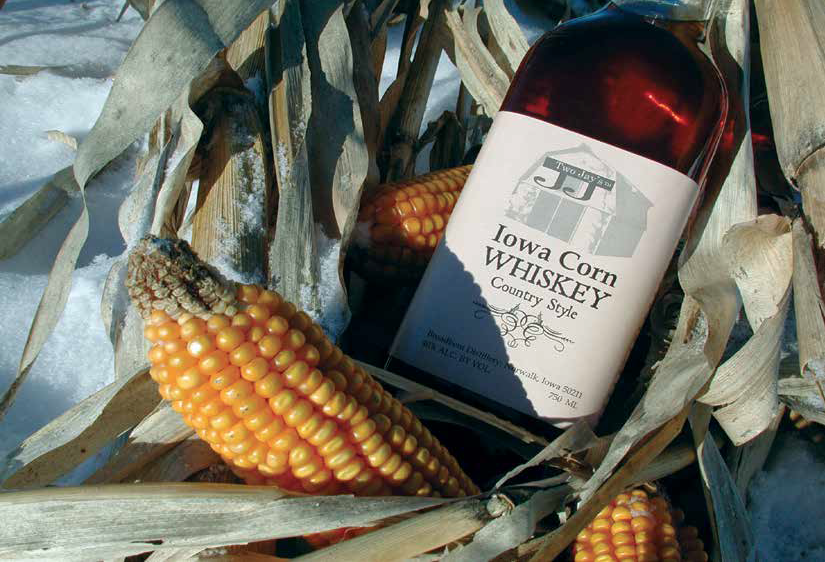Iowa Barn Whiskey
John Broadbent cooks corn liquor on a homemade still in his barn. It isn’t moonshine. It’s country-style Iowa corn whiskey. And Broadbent Distillery is the smallest legal whiskey maker in Iowa.
Broadbent and his son John, Jr.—the two Jays on their product labels—began their operation in 2009 on their farm near Norwalk, when John Sr. built their first still. They received their license from the Federal Tax and Trade Bureau later that year and started learning the art of distillation. That still is still in use today, with a few improvements.
Broadbent started out making grappa, a potent, robust drink made from grape seeds, pulp and skins, everything the wineries throw away, re-fermented and re-distilled.
Grappa is like brandy on steroids, and there isn’t much demand for it in Iowa.
“In Europe, they use it as an after dinner drink and in coffee,” Broadbent said. “I think it’s fantastic in coffee.”
He made his first batch from the 2010 grape harvest and delivered his first case to the Iowa Alcohol and Beverages Division in January 2011.
At his son’s suggestion, Broadbent decided to try making whiskey with Iowa’s golden harvest. Most whiskeys combine grains—wheat, barley, corn, rye—but Broadbent liked his son’s idea of all corn. “That is our secret formula—a hundred per cent corn,” Broadbent said. “It’s a little more expensive, but it makes a better product.” Corn whiskey must be at least 51% corn by law.
Broadbent begins a batch of whiskey by cooking the corn in an old cold storage milk tank. He fills most of it with water and adds about five bushels, or 250 pounds of ground corn, heats it to 154 degrees, then cooks it an hour and half longer to separate out the sugars. “That creates long sugars, and once it’s cooked out, I heat it on up to 186 degrees for sterilization, to kill any wild yeast or bacteria,” he said.
The mash is pumped into barrels and allowed to cool to 130 degrees, at which point Broadbent adds yeast and an enzyme to break the long sugars down to short sugars.
“After a lot of testing with types of yeasts, I decided on a specific type of dry yeast for the final taste and its ability to ferment at high alcohol proof,” he said. “The short sugar is what the yeast needs when it ferments all the sugars to alcohol.”
Broadbent keeps the barrels of mash in a small room so it won’t go below 70 degrees while fermenting, which takes about a week. After fermentation, he separates the solids from clear liquid, which is about ten per cent alcohol at that point. It’s run through a continuous still to strip all the alcohols out; the result is around 50 proof, or 25 per cent alcohol, and includes the heads, hearts and the tails. Heads are the poisonous vapors that boil off first—acetones, methanol and acetates. Hearts are the desired ethanol, and they evaporate at a higher temperature than the heads. Then come the tails, which are low in ethanol and not pleasant tasting.
“Back in the old days, the moonshiners wouldn’t separate the heads, hearts and tails and that would make people sick and go blind,” Broadbent said.
The 50-proof first run is collected in a barrel and sent through a reflux still. As the vapor cools in the spiraling copper coils, it condenses back to a liquid, and Broadbent separates the ethanol from the bad stuff.
He processes 25 gallons in a batch, and does his own tasting to refine the hearts.
“Each batch I distill will be a little bit different because of temperatures and the source of the corn from different fields and so on,” he said. “The highest proof alcohol comes out first.”
That would be good stuff to start a woodburning fireplace, but it goes back into the mash tank to distill again, rendering more hearts. “I might get another ten or twelve gallons, and that’s what goes on to the next step.”
The tails come after the good stuff, and it’s still pretty good alcohol until the higher temperature alcohols—isopropyl, or rubbing alcohol, for example—start coming out.
“The first time through the reflux still, I collect at 172 degrees to 190 degrees. That is what makes up my hearts,” Broadbent said. “The second time through, I collect 172 degrees to 180 degrees. That is what I bottle.”
The clear whiskey is then run through a half-micron filter. 200 microns is the size of an average human hair.
On it’s way to the bottling tank, the whiskey passes through an ultraviolet light to kill all single cell bacteria. Whiskey destined for oaking is pumped back upstairs and filtered again. Marketing the clear whiskey was tough.
“I was getting comments from bars and restaurants that customers thought it would be like moonshine, because it was clear,” he said. “This is fairly soft for a whiskey, but they thought it would be harsh.” The two Jays decided to produce a traditional, amber whiskey.
Broadbent ages his with a modern oak chip process rather than in expensive oak barrels. The clear distillate is pumped into high-density food grade barrels full of cleaned oak chips. With the wood in the whiskey, it gets more surface area exposure than within a barrel. Local sawmills may not be 100% oak and would thus require cleaning, so Broadbent gets his chips from a specialist in Pennsylvania.
The longer the whiskey is exposed to oak, the more the color changes, and it took Broadbent some experimenting before he found the right ratio and time.
“About halfway through, the color started coming in like I wanted, but it tasted like biting on a oak tree,” he said. “The color comes in on a straight graph, but the flavor goes up and down. So we left it longer for the color and the flavor was acceptable.”
Their Country Style whiskey is darker than Jim Beam and lighter than Jack Daniels.
Broadbent doesn’t re-use the chips. He could, but that would mean more time spent on testing.
“I have my formula and I have my time for flavor and color: grams of chips to milliliters of whiskey,” he said. “I collect the used chips in a barrel, and every so often, someone who does barbecue comes and gets a bag.”
After oaked whiskey sits in the bottle, it flocculates, creating a small amount of cloudy precipitate that comes from the oak. Broadbent decided that was a good thing.
“I found out that when whiskey is judged internationally, they look for that because it shows it is natural,” he said. “I could filter it down and color it back, but I didn’t want that for my product. I didn’t want any concentrations in my whiskey.”
Flocculation is a bit like the Japanese aesthetic of wabi-sabi, wherein something must have an imperfection before it can be considered perfect. All one need do is shake the bottle gently and it clears up. Broadbent also offers custom fruit-flavored whiskey products, including Limoncello and Orangecello, made with fresh lemons and oranges. It’s quite tasty stuff, but not an easy sell.
“With the Cellos, it’s a marketing mountain. I don’t know if we will get over that mountain or not,” he said. “I don’t like to go out knocking on doors and would be happy being here 24/7and working with the stills and bottling.”
The orange and lemon juice is freshly squeezed, not filtered, and thus the Cellos have plenty of stuff drifting about in the bottle. “When you walk down the aisle in the grocery store, you don’t expect to see things floating in alcohol,” Broadbent said. “What is in there is pulp from oranges and lemons, so when you drink it, it’s like drinking orange juice out of the refrigerator. If you give it a good shake, it mixes right in. I could filter it out, or not go through the hassle of squeezing fresh fruit and use a concentrate.”
But then it wouldn’t be a Broadbent product.
Broadbent also produces a private label, Juggs Cherry Cha-Chas, for a client in Nebraska who convinced him to make the product with cherry concentrate because profits go to cancer charities. “In a tavern or restaurant, a lot of people drink wine and beer, so the Cellos and Cha Chas are diluted down to 12.5 percent alcohol, closer to wine or beer,” he said.
Broadbent sold about 2000 bottles of whiskey in 2013. He said he had visitors for distillery tours from 22 different states plus Canada in 2013.
“That’s pretty much it,” he concluded.
Two Jays Iowa Corn Whiskeys are available at many of the larger Hy-Vee stores. Those and the Cellos and Cha Chas are available by request at John’s Grocery in Iowa City.
You can read more and contact the Broadbents at TwoJaysIowa.com.





